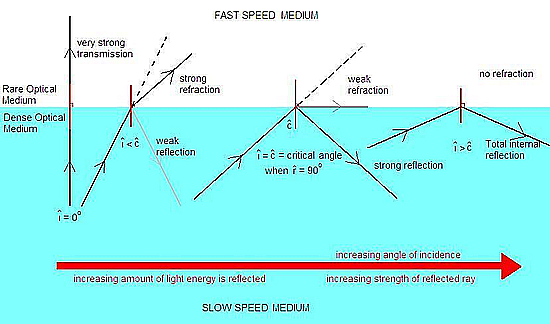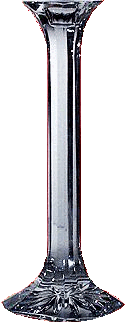| When
a wave hits a boundary with a medium that it can travel faster in (e.g.
light going from glass into air) it will be refracted
through a larger angle than its angle of incidence.
The bigger
the angle of incidence gets the bigger the angle of refraction will get.
This has a limit though! The angle of refraction cannot get bigger than
90o.
A special
name is given to the angle of incidence that produces an angle of refraction
of 90o. It is called the critical angle.
If the
angle of incidence gets any bigger refraction is not possible and all
the light is then reflected.Total Internal Reflection causes 100% reflection.
In no other situation in nature does this occur, so it is unique and very
useful as it is 100% efficient at transfering the light energy.

If you
observe carefully when you carry out an experiment into refraction you
will notice that light is not just refracted but that some of it is reflected
as well. The larger the angle of incidence the more of the light is reflected
and less of it passes into the other medium. You therefore get weak reflection
and good transmission into the other medium (refraction) with a small
angle of incidence and stronger reflection and less transmission as the
angle of incidence gets bigger. When it reaches the critical angle you
get NO transmission of the light into the other medium, it is all reflected.
That is why it is called TOTAL internal reflection, and that is why you
must always include that word TOTAL when it applies.
Total
internal reflection occurs when:
-
a ray of light is incident upon a boundary with an optically
rarer medium (one that makes it speed up) and
- the
angle of incidence is greater than the critical angle.
(You
must mention BOTH points when asked to explain the conditions under which
TIR will be observed).
The
critical angle is the angle of incidence that produces an angle of refraction
of 90o.
Click
here for total internal reflection within a
45o prism.
 Diamonds Diamonds
 From
glass to air the critical angle is about 42o but it varies
from one medium to another. The material that gives the smallest critical
angle is diamond. That is why they sparkle so much! Rays of light can
easily be made to 'bounce around inside them' by careful cutting of the
stone and the refraction at the surfaces splits the light into a spectrum
of colours! From
glass to air the critical angle is about 42o but it varies
from one medium to another. The material that gives the smallest critical
angle is diamond. That is why they sparkle so much! Rays of light can
easily be made to 'bounce around inside them' by careful cutting of the
stone and the refraction at the surfaces splits the light into a spectrum
of colours!
Relatively speaking,
the critical angle 24.4o for the diamond-air boundary is extremely
small. This property of the diamond-air boundary plays an important role
in the brilliance of a diamond gemstone. Having a small critical angle,
light has the tendency to become "trapped" inside of a diamond
once it enters. Most rays approach the diamond at angles of incidence
greater than the critical angle (as it is so small) so a light ray will
typically undergo TIR several times before finally refracting out of the
diamond. This gives diamond a tendency to sparkle. The effect can be enhanced
by the cutting of a diamond gemstone with a 'strategically' planned shape.
The diagram to the left depicts the total internal reflection within a
diamond gemstone with a 'strategic' and a 'non-strategic' cut.
 'Cut'
Glass or Lead Crystal 'Cut'
Glass or Lead Crystal
Cut glass is made
of a glass that contains heavy elements such as lead. This gives it a
smaller critical angle between the glass and air as the glass is denser
and makes it sparkle more when it is cut into facets.
It is sought after
for tableware, decorative glassware and in chandeliers.
Uses
of Total Internal Reflection
Fibre
Optic Cables (see separate page on this - it is a very important use
with many applications)
Two types of optical
fibre are used in telecommunications:
- Step-index fibre
- The core is made from on type of glass while the outer cladding has
a lower refractive index.
- Graded-index fibre
- The refractive index of the material gradually decreases outwards
from the centre of the fibre.
Before optical fibres
had been developed, telecommunications used copper cables. Because of
copper's resistance (changing some of the energy into heat), signals were
reduced and had to be re-amplified every few kilometres. Compared to copper
cables, optical fibres are far more efficient, less bulky and heavey and
much cheaper (they are made from sand!).
- Local Area Networks
- Cable TV
- CCTV
- Astronomy
If light from several
stars or galaxies needs to be studied simultaneously (for example to analyse
red-shift or spectra). Optical fibres are then bundled together and placed
at the focus of a telescope in a block. Each optical fibre receives light
from parts of the image of the sky, fibres then lead the light to an instrument
where it can be studied by translating the ligt into an electrical signal
and feeding the collected data into a computer.
- Optical Fibre
Sensors
- The endoscope
or fibroscope
An endoscope
is any instrument used to look inside the body. Thousands of optical
fibres are bundled together in an endoscope which is inserted into
a human body so that the doctor can 'see' inside. Light can be directed
down the fibres even if they are bent, allowing the surgeon to illuminate
the area under observation (an incoherent bundle is used to do this!).
S/he can then view this from a television camera linked to a monitor
by coherent fibres.
Usually consisting of a fiber-optic tube attached to a viewing device,
endoscopes can be used to explore and biopsy such areas as the colon
and the bronchi of the lungs. By employing miniature television
cameras and tiny surgical implements thy allow not only exploration
but also endoscopic surgery. Through small incisions; such surgery
is much less traumatic to the patient than traditional open surgery.
Recovery times are shorter, and less anaesthetic is required (sometimes
none!).
Examples
of surgical uses:
- Laparoscopic
surgery, in which the endoscope is inserted through a small incision
in the abdomen or chest, is used to correct abnormalities of the
ovaries and as an alternative to traditional gall bladder and
chest surgery.
- Arthroscopic
surgery is endoscopic surgery performed on joints such as the
knee or shoulder.
Endoscopes
are widely used both in medical and vetenary practices. The physics
principle on which they are based is total internal reflection within
a fibre optic bundle of fibres.
Prismatic
Optical Instruments
Some optical instruments,
such as periscopes and binoculars use prisms instead of mirrors to reflect
light around corners. This is because mirrors do not reflect light as
totally as prisms do (mirrors only reflect about 95% of that reflected
by prisms under TIR conditions). Also refraction distortion can result
in using a glass fronted mirror. Therefore the image is crisper and brighter.
In prismatic binoculars, total internal reflection in prisms is used to
extend the path length between objective and eyepiece, effectively `folding'
the optical path.
This makes them compact and easy to carry.
Bicycle Reflector
If you position two
mirrors at a right angle to each other, all of the incoming light will
bounce twice and then retrace approximately the same path on its way out.
(Try it out, and you'll discover thatt the image that you see in the mirror-pair
is NOT laterally inverted as it would be in a single mirror!). If you
put THREE mirrors together and look into the corner of them, you'll see
an upside-down, unreversed image of your face. And no matter how you twist
the mirrors or move your head, the image of your face will stay in the
same spot. This device is called a CORNER-CUBE REFLECTOR. It returns incoming
light back to its source.
Bicycle reflectors
are composed of hundreds of tiny Corner-Cube Reflectors formed into the
plastic - a 'Corner-Cube Array'.
When you look deeply
into a white bicycle reflector close up you will notice that it looks
black. The black colour is actually the upside-down image of your eye's
dark pupil! If the reflector facets were lots bigger, you'd see an image
of your eye within each one. Gaze at the reflector while slowly moving
the edge of a white piece of paper across your eye, and just before it
blocks your vision, you'll see small white bits appear in the facets of
the bicycle reflector.
If you take one apart,
you'll find that the faceted back of the plastic is NOT a metal-coated
mirror. In fact, if it was metallized, it would only reflect about 80%
of the light; same as normal mirrors. Without the metal, it reflects 100%
of the light (if it is made of transparent plastic!) by using Total Internal
Reflection instead. The reflectors, however, are manufactured in different
colours of plastic material so that they only reflect a portion of the
light in the desired colour (e.g. 'red' on the back of a bike). The coloured
plastic works like a filter - (if you cycle
see here).
|




 Total
Internal Reflection
Total
Internal Reflection


 From
glass to air the critical angle is about 42o but it varies
from one medium to another. The material that gives the smallest critical
angle is diamond. That is why they sparkle so much! Rays of light can
easily be made to 'bounce around inside them' by careful cutting of the
stone and the refraction at the surfaces splits the light into a spectrum
of colours!
From
glass to air the critical angle is about 42o but it varies
from one medium to another. The material that gives the smallest critical
angle is diamond. That is why they sparkle so much! Rays of light can
easily be made to 'bounce around inside them' by careful cutting of the
stone and the refraction at the surfaces splits the light into a spectrum
of colours! 'Cut'
Glass or Lead Crystal
'Cut'
Glass or Lead Crystal
